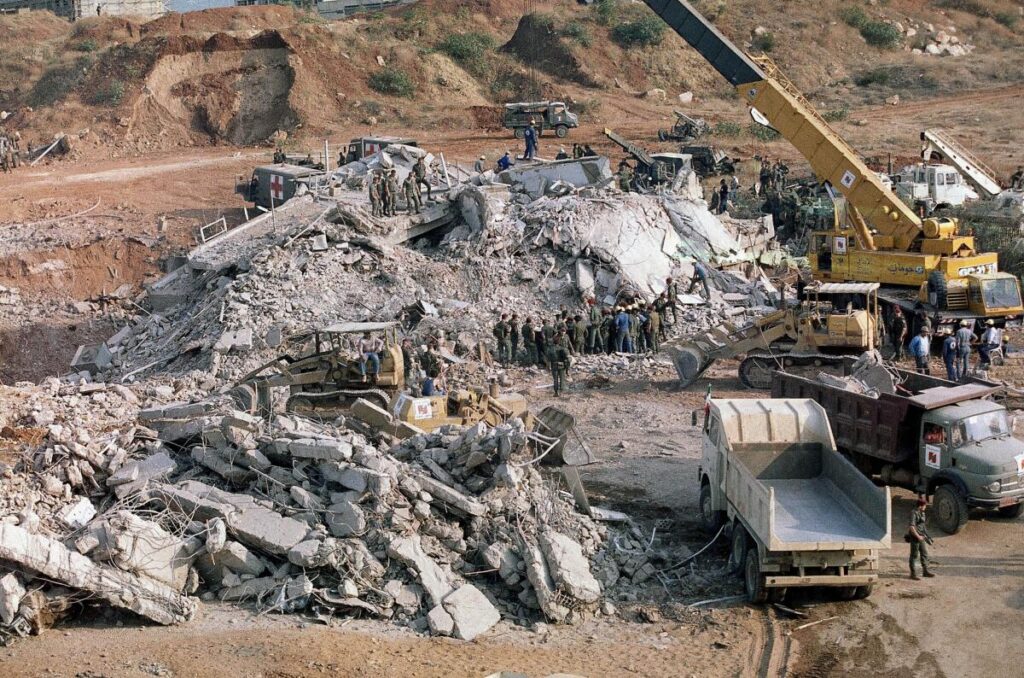
Forty years after one of the deadliest attacks against U.S. troops in the Middle East, some warn that Washington could be sliding toward a new conflict in the region.
On Oct. 23, 1983, a suicide bomber hit an American military barracks at Beirut International Airport, killing 241 U.S. service members, most of them Marines – still the deadliest attack on Marines since the World War II Battle of Iwo Jima. A near-simultaneous attack on French forces killed 58 paratroopers.
Washington blames the bombings on the Lebanese militant group Hezbollah, a claim the Iranian-backed Hezbollah denies. The U.S. and French forces were in Beirut as part of a multinational force deployed amid Israel’s 1982 invasion of Lebanon. The force oversaw the withdrawal of Palestinian fighters from Beirut and stayed afterward to help a Western-backed government at the time. The bombing prompted a U.S. withdrawal from Lebanon.
The United States is now deploying forces again in the region in connection to a war between Israel and its enemies.
The aircraft carrier USS Gerald R. Ford has been positioned in the eastern Mediterranean along with other American warships – with a second carrier on the way – in what is widely seen as a message to Iran and Hezbollah not to open new fronts as Israel fights Hamas.
The war risks spiraling into a wider regional conflict. The biggest worry is over the Lebanon-Israel border, where Israel and Hezbollah exchange fire on a daily basis.
But there are other spots where the U.S. could be dragged directly into the fight. There are roughly 2,500 U.S. troops in Iraq and around 900 others in eastern Syria, on missions against the Islamic State group. In both countries, Iran has militias loyal to it that already have opened fire on the Americans since the Gaza war erupted.
A Hezbollah supporter who goes by the name of Haj Mohammed posted a video on Tiktok on Oct. 13 that drew a threatening parallel between the barracks bombing 40 years ago and present-day events.
“It seems that Uncle Joe did not tell the commanders of these warships and aircraft carriers about what happened on October 23, 1983,” the man said, referring to President Joe Biden. Sitting in front of a poster of Jerusalem’s Dome of the Rock, he wondered aloud whether U.S. troops will return home in coffins again.
Iran-backed groups have issued threats against the U.S. if it joins the war on the side of Israel.
Top Hezbollah official Hachem Safieddine said in a speech that there are tens of thousands of fighters around the region “whose fingers are on the trigger.”
The commander of a powerful Iranian-backed militia in Iraq posted a photo of himself on social media standing by the Lebanon-Israel border in an apparent show that his fighters are ready for war.
If the U.S. intervenes directly in the Israel-Hamas war, “then the American presence in the region becomes legitimate targets for resistance fighters whether in Iraq or elsewhere,” the commander — Abu Alaa al-Walae of Iraq’s Kataib Sayyid al-Shuhada — told Beirut-based Al-Mayadeen TV.
Since Wednesday, suicide drones and rockets have hit several bases housing U.S. troops in Iraq and Syria. The attacks were either claimed by or blamed on Iranian-backed militias.
A U.S. Navy warship on Thursday intercepted three missiles and several drones fired by Iranian-backed Houthi rebels from Yemen, potentially toward targets in Israel, the Pentagon said.
American forces could also come under attack if Israel launches a ground invasion of Gaza and appears about to destroy Hamas, as it has vowed to do.




